Report: Motivation and Finance Strategies for Tesco's New Venture
VerifiedAdded on 2023/01/11
|11
|2594
|48
Report
AI Summary
This report delves into crucial aspects of business management, focusing on employee motivation and financial strategies within the context of Tesco's new discount store, Jack. It begins by exploring motivation theories, including Maslow's hierarchy of needs and Herzberg's Two-Factor Theory, and their application in enhancing employee dedication and job satisfaction. The report then transitions to the financial domain, examining both short-term and long-term sources of finance, such as installment credit, consumer credit, equity capital, and term loans. Finally, it analyzes investment appraisal techniques like payback period, net present value (NPV), and accounting rate of return, providing recommendations for effective financial decision-making. The analysis aims to provide insights into how Tesco can successfully launch and manage its new venture, considering both human resources and financial planning.
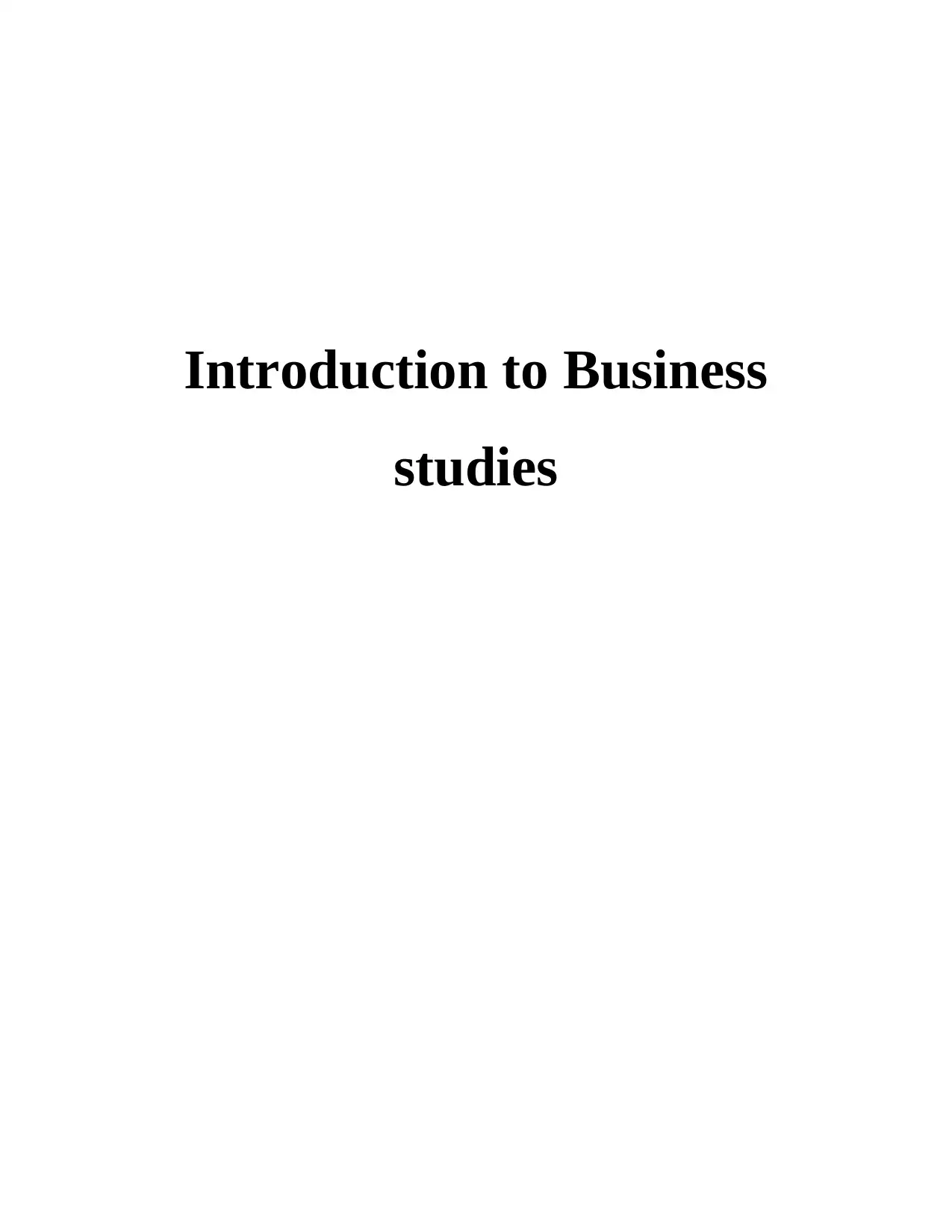
Introduction to Business
studies
studies
Paraphrase This Document
Need a fresh take? Get an instant paraphrase of this document with our AI Paraphraser
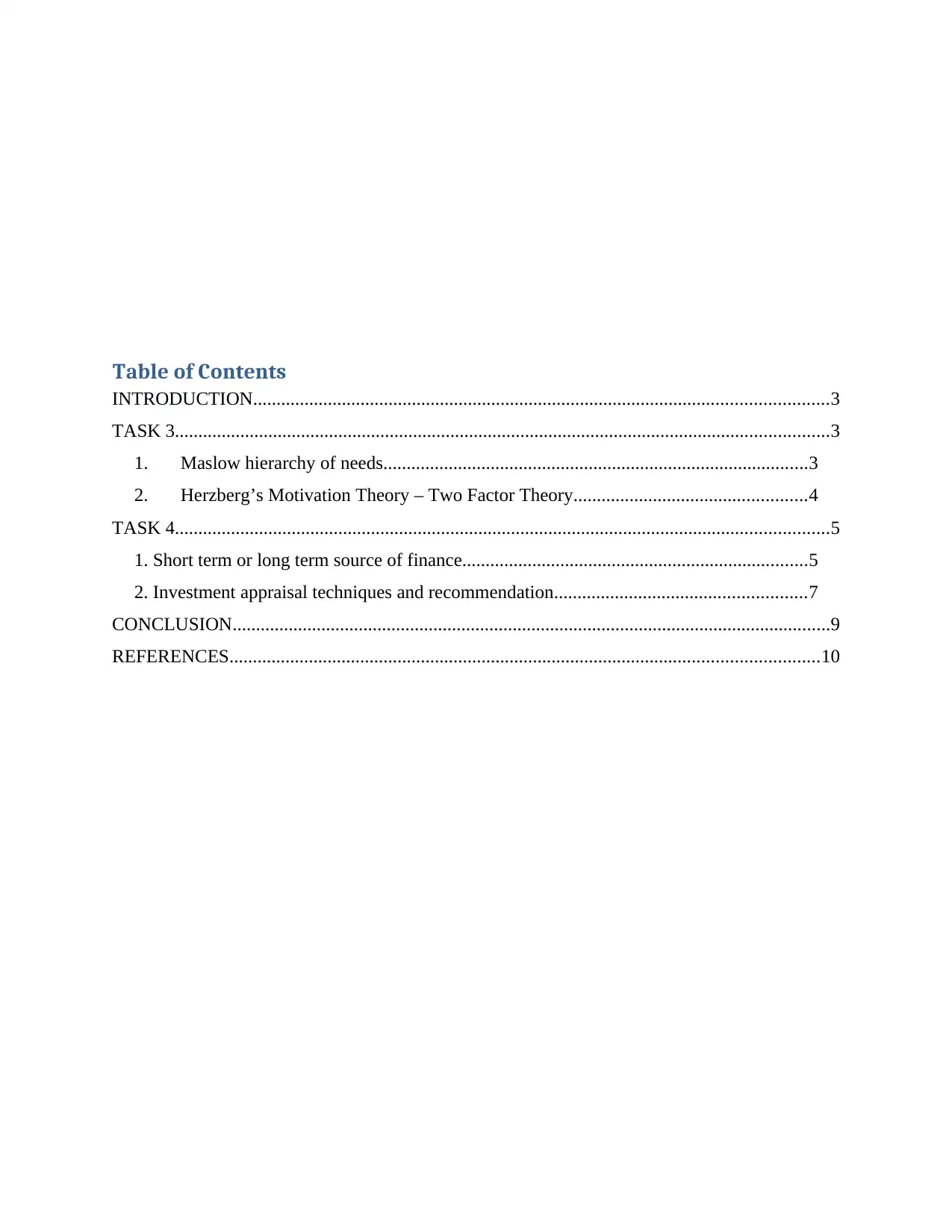
Table of Contents
INTRODUCTION...........................................................................................................................3
TASK 3............................................................................................................................................3
1. Maslow hierarchy of needs...........................................................................................3
2. Herzberg’s Motivation Theory – Two Factor Theory..................................................4
TASK 4............................................................................................................................................5
1. Short term or long term source of finance..........................................................................5
2. Investment appraisal techniques and recommendation......................................................7
CONCLUSION................................................................................................................................9
REFERENCES..............................................................................................................................10
INTRODUCTION...........................................................................................................................3
TASK 3............................................................................................................................................3
1. Maslow hierarchy of needs...........................................................................................3
2. Herzberg’s Motivation Theory – Two Factor Theory..................................................4
TASK 4............................................................................................................................................5
1. Short term or long term source of finance..........................................................................5
2. Investment appraisal techniques and recommendation......................................................7
CONCLUSION................................................................................................................................9
REFERENCES..............................................................................................................................10
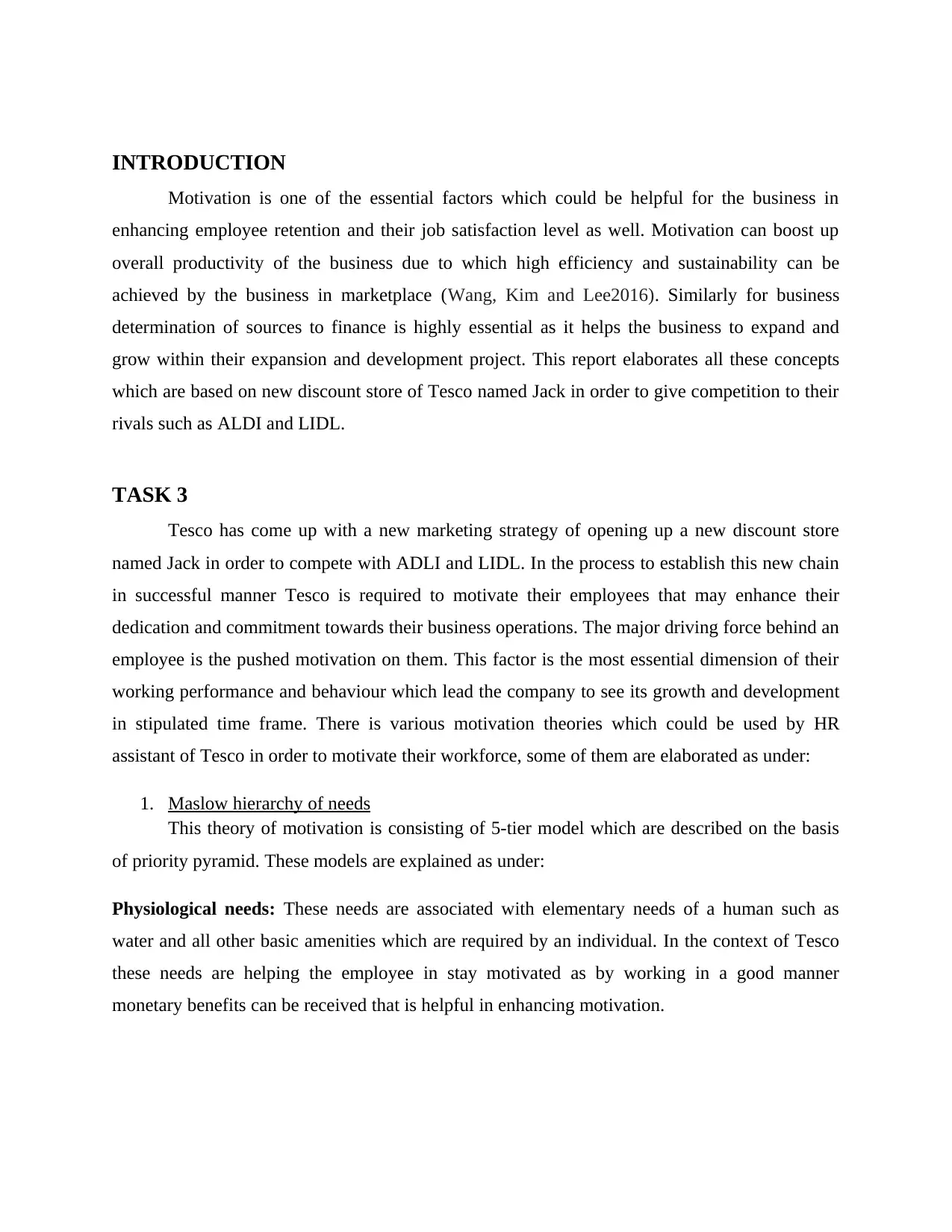
INTRODUCTION
Motivation is one of the essential factors which could be helpful for the business in
enhancing employee retention and their job satisfaction level as well. Motivation can boost up
overall productivity of the business due to which high efficiency and sustainability can be
achieved by the business in marketplace (Wang, Kim and Lee2016). Similarly for business
determination of sources to finance is highly essential as it helps the business to expand and
grow within their expansion and development project. This report elaborates all these concepts
which are based on new discount store of Tesco named Jack in order to give competition to their
rivals such as ALDI and LIDL.
TASK 3
Tesco has come up with a new marketing strategy of opening up a new discount store
named Jack in order to compete with ADLI and LIDL. In the process to establish this new chain
in successful manner Tesco is required to motivate their employees that may enhance their
dedication and commitment towards their business operations. The major driving force behind an
employee is the pushed motivation on them. This factor is the most essential dimension of their
working performance and behaviour which lead the company to see its growth and development
in stipulated time frame. There is various motivation theories which could be used by HR
assistant of Tesco in order to motivate their workforce, some of them are elaborated as under:
1. Maslow hierarchy of needs
This theory of motivation is consisting of 5-tier model which are described on the basis
of priority pyramid. These models are explained as under:
Physiological needs: These needs are associated with elementary needs of a human such as
water and all other basic amenities which are required by an individual. In the context of Tesco
these needs are helping the employee in stay motivated as by working in a good manner
monetary benefits can be received that is helpful in enhancing motivation.
Motivation is one of the essential factors which could be helpful for the business in
enhancing employee retention and their job satisfaction level as well. Motivation can boost up
overall productivity of the business due to which high efficiency and sustainability can be
achieved by the business in marketplace (Wang, Kim and Lee2016). Similarly for business
determination of sources to finance is highly essential as it helps the business to expand and
grow within their expansion and development project. This report elaborates all these concepts
which are based on new discount store of Tesco named Jack in order to give competition to their
rivals such as ALDI and LIDL.
TASK 3
Tesco has come up with a new marketing strategy of opening up a new discount store
named Jack in order to compete with ADLI and LIDL. In the process to establish this new chain
in successful manner Tesco is required to motivate their employees that may enhance their
dedication and commitment towards their business operations. The major driving force behind an
employee is the pushed motivation on them. This factor is the most essential dimension of their
working performance and behaviour which lead the company to see its growth and development
in stipulated time frame. There is various motivation theories which could be used by HR
assistant of Tesco in order to motivate their workforce, some of them are elaborated as under:
1. Maslow hierarchy of needs
This theory of motivation is consisting of 5-tier model which are described on the basis
of priority pyramid. These models are explained as under:
Physiological needs: These needs are associated with elementary needs of a human such as
water and all other basic amenities which are required by an individual. In the context of Tesco
these needs are helping the employee in stay motivated as by working in a good manner
monetary benefits can be received that is helpful in enhancing motivation.
⊘ This is a preview!⊘
Do you want full access?
Subscribe today to unlock all pages.

Trusted by 1+ million students worldwide
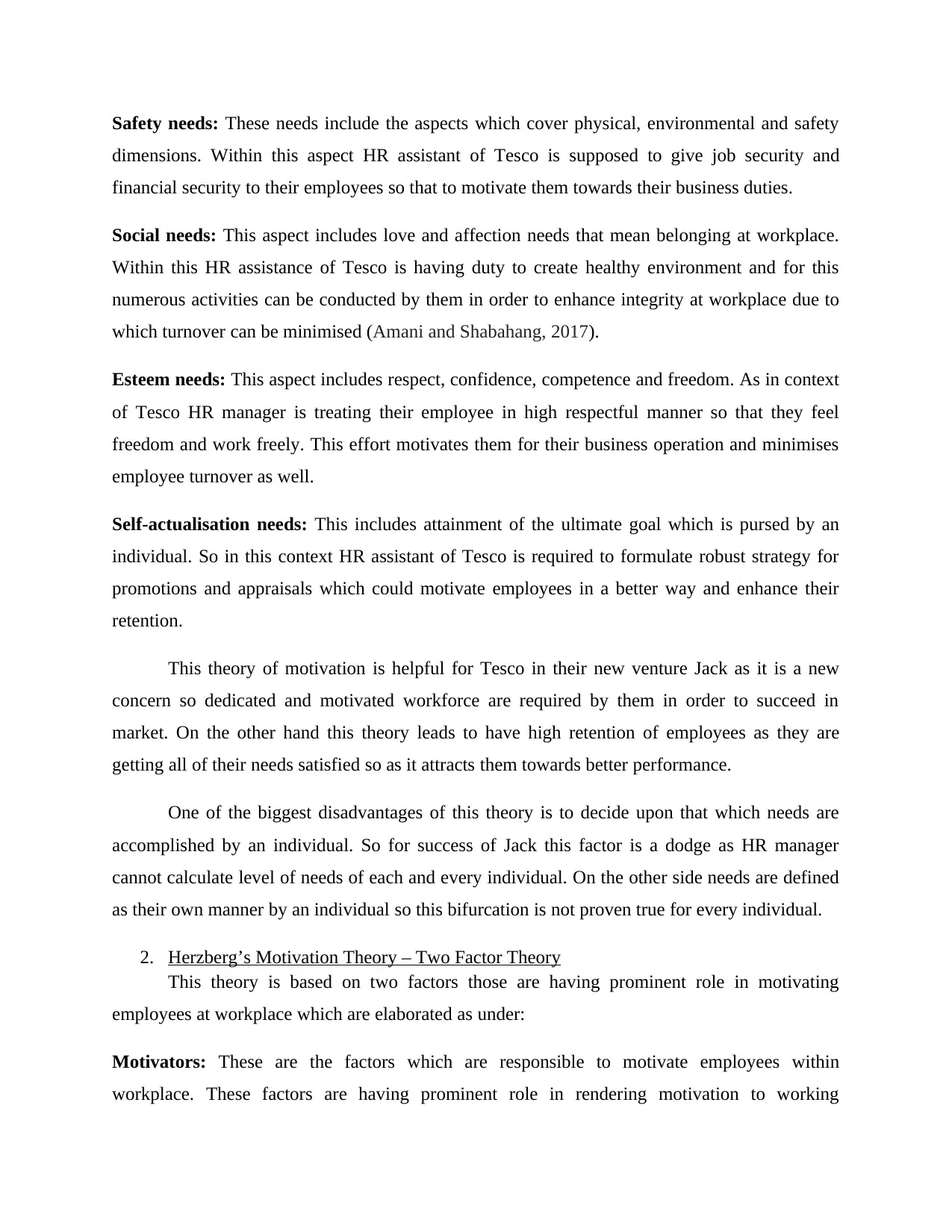
Safety needs: These needs include the aspects which cover physical, environmental and safety
dimensions. Within this aspect HR assistant of Tesco is supposed to give job security and
financial security to their employees so that to motivate them towards their business duties.
Social needs: This aspect includes love and affection needs that mean belonging at workplace.
Within this HR assistance of Tesco is having duty to create healthy environment and for this
numerous activities can be conducted by them in order to enhance integrity at workplace due to
which turnover can be minimised (Amani and Shabahang, 2017).
Esteem needs: This aspect includes respect, confidence, competence and freedom. As in context
of Tesco HR manager is treating their employee in high respectful manner so that they feel
freedom and work freely. This effort motivates them for their business operation and minimises
employee turnover as well.
Self-actualisation needs: This includes attainment of the ultimate goal which is pursed by an
individual. So in this context HR assistant of Tesco is required to formulate robust strategy for
promotions and appraisals which could motivate employees in a better way and enhance their
retention.
This theory of motivation is helpful for Tesco in their new venture Jack as it is a new
concern so dedicated and motivated workforce are required by them in order to succeed in
market. On the other hand this theory leads to have high retention of employees as they are
getting all of their needs satisfied so as it attracts them towards better performance.
One of the biggest disadvantages of this theory is to decide upon that which needs are
accomplished by an individual. So for success of Jack this factor is a dodge as HR manager
cannot calculate level of needs of each and every individual. On the other side needs are defined
as their own manner by an individual so this bifurcation is not proven true for every individual.
2. Herzberg’s Motivation Theory – Two Factor Theory
This theory is based on two factors those are having prominent role in motivating
employees at workplace which are elaborated as under:
Motivators: These are the factors which are responsible to motivate employees within
workplace. These factors are having prominent role in rendering motivation to working
dimensions. Within this aspect HR assistant of Tesco is supposed to give job security and
financial security to their employees so that to motivate them towards their business duties.
Social needs: This aspect includes love and affection needs that mean belonging at workplace.
Within this HR assistance of Tesco is having duty to create healthy environment and for this
numerous activities can be conducted by them in order to enhance integrity at workplace due to
which turnover can be minimised (Amani and Shabahang, 2017).
Esteem needs: This aspect includes respect, confidence, competence and freedom. As in context
of Tesco HR manager is treating their employee in high respectful manner so that they feel
freedom and work freely. This effort motivates them for their business operation and minimises
employee turnover as well.
Self-actualisation needs: This includes attainment of the ultimate goal which is pursed by an
individual. So in this context HR assistant of Tesco is required to formulate robust strategy for
promotions and appraisals which could motivate employees in a better way and enhance their
retention.
This theory of motivation is helpful for Tesco in their new venture Jack as it is a new
concern so dedicated and motivated workforce are required by them in order to succeed in
market. On the other hand this theory leads to have high retention of employees as they are
getting all of their needs satisfied so as it attracts them towards better performance.
One of the biggest disadvantages of this theory is to decide upon that which needs are
accomplished by an individual. So for success of Jack this factor is a dodge as HR manager
cannot calculate level of needs of each and every individual. On the other side needs are defined
as their own manner by an individual so this bifurcation is not proven true for every individual.
2. Herzberg’s Motivation Theory – Two Factor Theory
This theory is based on two factors those are having prominent role in motivating
employees at workplace which are elaborated as under:
Motivators: These are the factors which are responsible to motivate employees within
workplace. These factors are having prominent role in rendering motivation to working
Paraphrase This Document
Need a fresh take? Get an instant paraphrase of this document with our AI Paraphraser
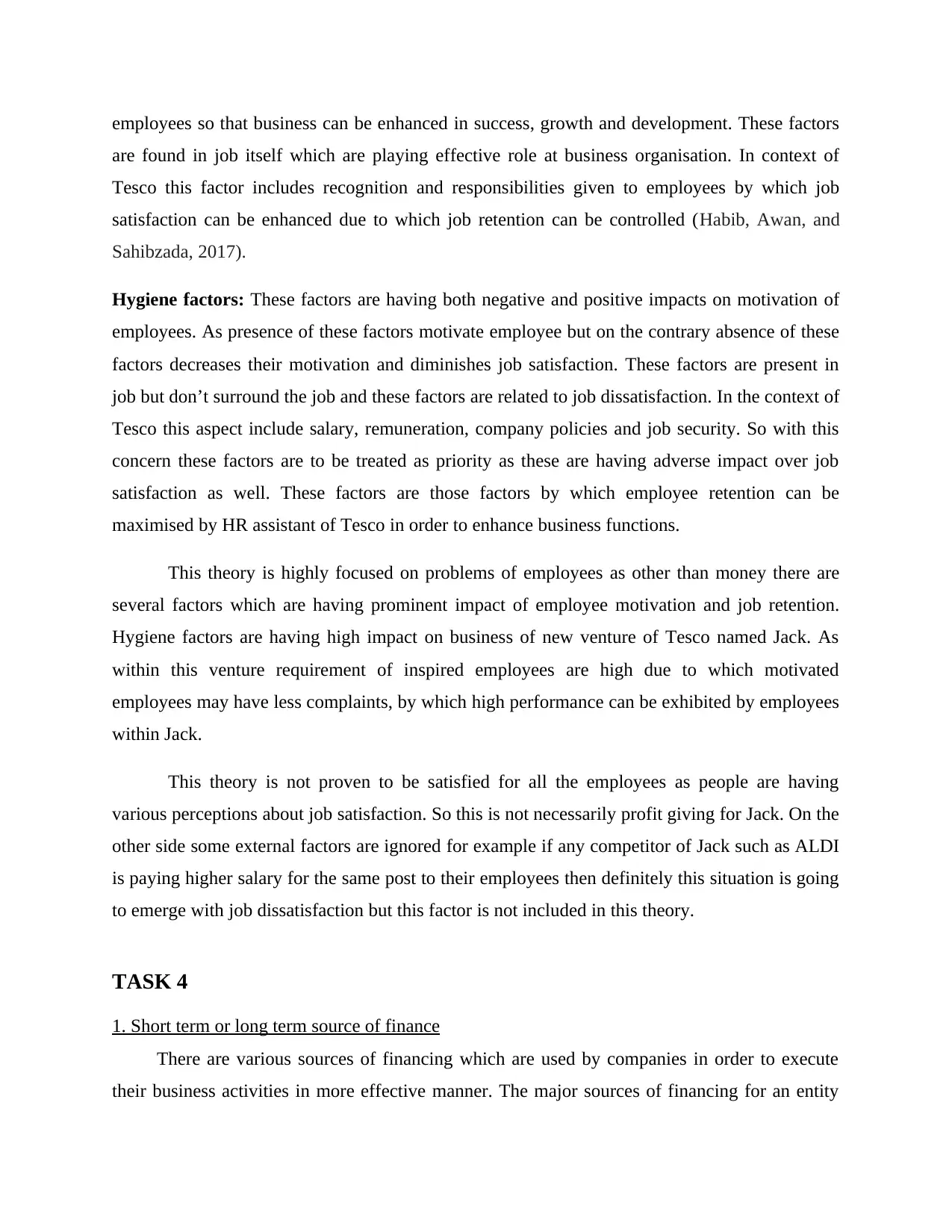
employees so that business can be enhanced in success, growth and development. These factors
are found in job itself which are playing effective role at business organisation. In context of
Tesco this factor includes recognition and responsibilities given to employees by which job
satisfaction can be enhanced due to which job retention can be controlled (Habib, Awan, and
Sahibzada, 2017).
Hygiene factors: These factors are having both negative and positive impacts on motivation of
employees. As presence of these factors motivate employee but on the contrary absence of these
factors decreases their motivation and diminishes job satisfaction. These factors are present in
job but don’t surround the job and these factors are related to job dissatisfaction. In the context of
Tesco this aspect include salary, remuneration, company policies and job security. So with this
concern these factors are to be treated as priority as these are having adverse impact over job
satisfaction as well. These factors are those factors by which employee retention can be
maximised by HR assistant of Tesco in order to enhance business functions.
This theory is highly focused on problems of employees as other than money there are
several factors which are having prominent impact of employee motivation and job retention.
Hygiene factors are having high impact on business of new venture of Tesco named Jack. As
within this venture requirement of inspired employees are high due to which motivated
employees may have less complaints, by which high performance can be exhibited by employees
within Jack.
This theory is not proven to be satisfied for all the employees as people are having
various perceptions about job satisfaction. So this is not necessarily profit giving for Jack. On the
other side some external factors are ignored for example if any competitor of Jack such as ALDI
is paying higher salary for the same post to their employees then definitely this situation is going
to emerge with job dissatisfaction but this factor is not included in this theory.
TASK 4
1. Short term or long term source of finance
There are various sources of financing which are used by companies in order to execute
their business activities in more effective manner. The major sources of financing for an entity
are found in job itself which are playing effective role at business organisation. In context of
Tesco this factor includes recognition and responsibilities given to employees by which job
satisfaction can be enhanced due to which job retention can be controlled (Habib, Awan, and
Sahibzada, 2017).
Hygiene factors: These factors are having both negative and positive impacts on motivation of
employees. As presence of these factors motivate employee but on the contrary absence of these
factors decreases their motivation and diminishes job satisfaction. These factors are present in
job but don’t surround the job and these factors are related to job dissatisfaction. In the context of
Tesco this aspect include salary, remuneration, company policies and job security. So with this
concern these factors are to be treated as priority as these are having adverse impact over job
satisfaction as well. These factors are those factors by which employee retention can be
maximised by HR assistant of Tesco in order to enhance business functions.
This theory is highly focused on problems of employees as other than money there are
several factors which are having prominent impact of employee motivation and job retention.
Hygiene factors are having high impact on business of new venture of Tesco named Jack. As
within this venture requirement of inspired employees are high due to which motivated
employees may have less complaints, by which high performance can be exhibited by employees
within Jack.
This theory is not proven to be satisfied for all the employees as people are having
various perceptions about job satisfaction. So this is not necessarily profit giving for Jack. On the
other side some external factors are ignored for example if any competitor of Jack such as ALDI
is paying higher salary for the same post to their employees then definitely this situation is going
to emerge with job dissatisfaction but this factor is not included in this theory.
TASK 4
1. Short term or long term source of finance
There are various sources of financing which are used by companies in order to execute
their business activities in more effective manner. The major sources of financing for an entity
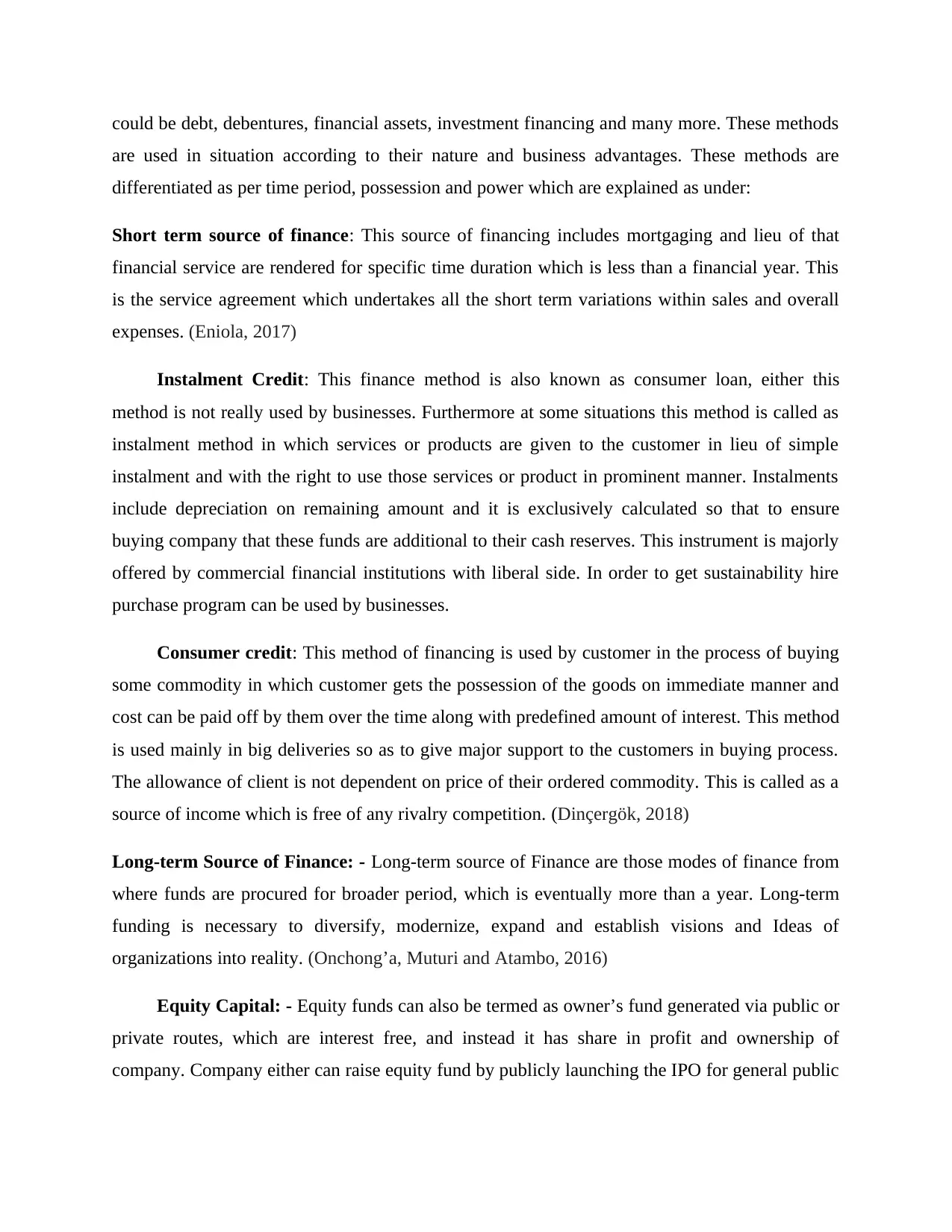
could be debt, debentures, financial assets, investment financing and many more. These methods
are used in situation according to their nature and business advantages. These methods are
differentiated as per time period, possession and power which are explained as under:
Short term source of finance: This source of financing includes mortgaging and lieu of that
financial service are rendered for specific time duration which is less than a financial year. This
is the service agreement which undertakes all the short term variations within sales and overall
expenses. (Eniola, 2017)
Instalment Credit: This finance method is also known as consumer loan, either this
method is not really used by businesses. Furthermore at some situations this method is called as
instalment method in which services or products are given to the customer in lieu of simple
instalment and with the right to use those services or product in prominent manner. Instalments
include depreciation on remaining amount and it is exclusively calculated so that to ensure
buying company that these funds are additional to their cash reserves. This instrument is majorly
offered by commercial financial institutions with liberal side. In order to get sustainability hire
purchase program can be used by businesses.
Consumer credit: This method of financing is used by customer in the process of buying
some commodity in which customer gets the possession of the goods on immediate manner and
cost can be paid off by them over the time along with predefined amount of interest. This method
is used mainly in big deliveries so as to give major support to the customers in buying process.
The allowance of client is not dependent on price of their ordered commodity. This is called as a
source of income which is free of any rivalry competition. (Dinçergök, 2018)
Long-term Source of Finance: - Long-term source of Finance are those modes of finance from
where funds are procured for broader period, which is eventually more than a year. Long-term
funding is necessary to diversify, modernize, expand and establish visions and Ideas of
organizations into reality. (Onchong’a, Muturi and Atambo, 2016)
Equity Capital: - Equity funds can also be termed as owner’s fund generated via public or
private routes, which are interest free, and instead it has share in profit and ownership of
company. Company either can raise equity fund by publicly launching the IPO for general public
are used in situation according to their nature and business advantages. These methods are
differentiated as per time period, possession and power which are explained as under:
Short term source of finance: This source of financing includes mortgaging and lieu of that
financial service are rendered for specific time duration which is less than a financial year. This
is the service agreement which undertakes all the short term variations within sales and overall
expenses. (Eniola, 2017)
Instalment Credit: This finance method is also known as consumer loan, either this
method is not really used by businesses. Furthermore at some situations this method is called as
instalment method in which services or products are given to the customer in lieu of simple
instalment and with the right to use those services or product in prominent manner. Instalments
include depreciation on remaining amount and it is exclusively calculated so that to ensure
buying company that these funds are additional to their cash reserves. This instrument is majorly
offered by commercial financial institutions with liberal side. In order to get sustainability hire
purchase program can be used by businesses.
Consumer credit: This method of financing is used by customer in the process of buying
some commodity in which customer gets the possession of the goods on immediate manner and
cost can be paid off by them over the time along with predefined amount of interest. This method
is used mainly in big deliveries so as to give major support to the customers in buying process.
The allowance of client is not dependent on price of their ordered commodity. This is called as a
source of income which is free of any rivalry competition. (Dinçergök, 2018)
Long-term Source of Finance: - Long-term source of Finance are those modes of finance from
where funds are procured for broader period, which is eventually more than a year. Long-term
funding is necessary to diversify, modernize, expand and establish visions and Ideas of
organizations into reality. (Onchong’a, Muturi and Atambo, 2016)
Equity Capital: - Equity funds can also be termed as owner’s fund generated via public or
private routes, which are interest free, and instead it has share in profit and ownership of
company. Company either can raise equity fund by publicly launching the IPO for general public
⊘ This is a preview!⊘
Do you want full access?
Subscribe today to unlock all pages.

Trusted by 1+ million students worldwide
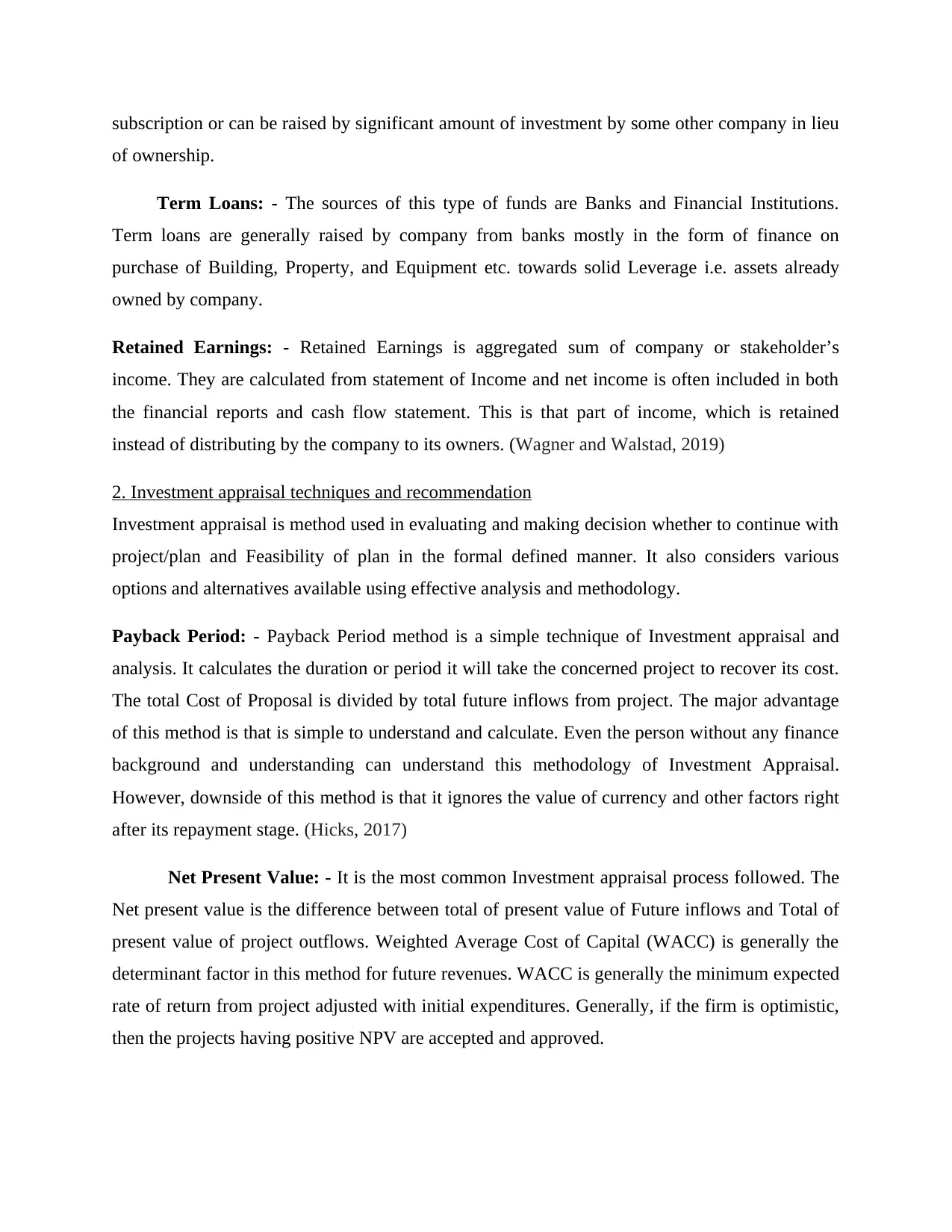
subscription or can be raised by significant amount of investment by some other company in lieu
of ownership.
Term Loans: - The sources of this type of funds are Banks and Financial Institutions.
Term loans are generally raised by company from banks mostly in the form of finance on
purchase of Building, Property, and Equipment etc. towards solid Leverage i.e. assets already
owned by company.
Retained Earnings: - Retained Earnings is aggregated sum of company or stakeholder’s
income. They are calculated from statement of Income and net income is often included in both
the financial reports and cash flow statement. This is that part of income, which is retained
instead of distributing by the company to its owners. (Wagner and Walstad, 2019)
2. Investment appraisal techniques and recommendation
Investment appraisal is method used in evaluating and making decision whether to continue with
project/plan and Feasibility of plan in the formal defined manner. It also considers various
options and alternatives available using effective analysis and methodology.
Payback Period: - Payback Period method is a simple technique of Investment appraisal and
analysis. It calculates the duration or period it will take the concerned project to recover its cost.
The total Cost of Proposal is divided by total future inflows from project. The major advantage
of this method is that is simple to understand and calculate. Even the person without any finance
background and understanding can understand this methodology of Investment Appraisal.
However, downside of this method is that it ignores the value of currency and other factors right
after its repayment stage. (Hicks, 2017)
Net Present Value: - It is the most common Investment appraisal process followed. The
Net present value is the difference between total of present value of Future inflows and Total of
present value of project outflows. Weighted Average Cost of Capital (WACC) is generally the
determinant factor in this method for future revenues. WACC is generally the minimum expected
rate of return from project adjusted with initial expenditures. Generally, if the firm is optimistic,
then the projects having positive NPV are accepted and approved.
of ownership.
Term Loans: - The sources of this type of funds are Banks and Financial Institutions.
Term loans are generally raised by company from banks mostly in the form of finance on
purchase of Building, Property, and Equipment etc. towards solid Leverage i.e. assets already
owned by company.
Retained Earnings: - Retained Earnings is aggregated sum of company or stakeholder’s
income. They are calculated from statement of Income and net income is often included in both
the financial reports and cash flow statement. This is that part of income, which is retained
instead of distributing by the company to its owners. (Wagner and Walstad, 2019)
2. Investment appraisal techniques and recommendation
Investment appraisal is method used in evaluating and making decision whether to continue with
project/plan and Feasibility of plan in the formal defined manner. It also considers various
options and alternatives available using effective analysis and methodology.
Payback Period: - Payback Period method is a simple technique of Investment appraisal and
analysis. It calculates the duration or period it will take the concerned project to recover its cost.
The total Cost of Proposal is divided by total future inflows from project. The major advantage
of this method is that is simple to understand and calculate. Even the person without any finance
background and understanding can understand this methodology of Investment Appraisal.
However, downside of this method is that it ignores the value of currency and other factors right
after its repayment stage. (Hicks, 2017)
Net Present Value: - It is the most common Investment appraisal process followed. The
Net present value is the difference between total of present value of Future inflows and Total of
present value of project outflows. Weighted Average Cost of Capital (WACC) is generally the
determinant factor in this method for future revenues. WACC is generally the minimum expected
rate of return from project adjusted with initial expenditures. Generally, if the firm is optimistic,
then the projects having positive NPV are accepted and approved.
Paraphrase This Document
Need a fresh take? Get an instant paraphrase of this document with our AI Paraphraser

Accounting Rate of Return: - The Accounting Rate of Return is a rate calculated by
dividing expected benefit from proposal with expenditure. It is the percentage of income over the
expenditure resulting from the sale or revenue. It is also termed as Rate of return or Investment
return.
dividing expected benefit from proposal with expenditure. It is the percentage of income over the
expenditure resulting from the sale or revenue. It is also termed as Rate of return or Investment
return.
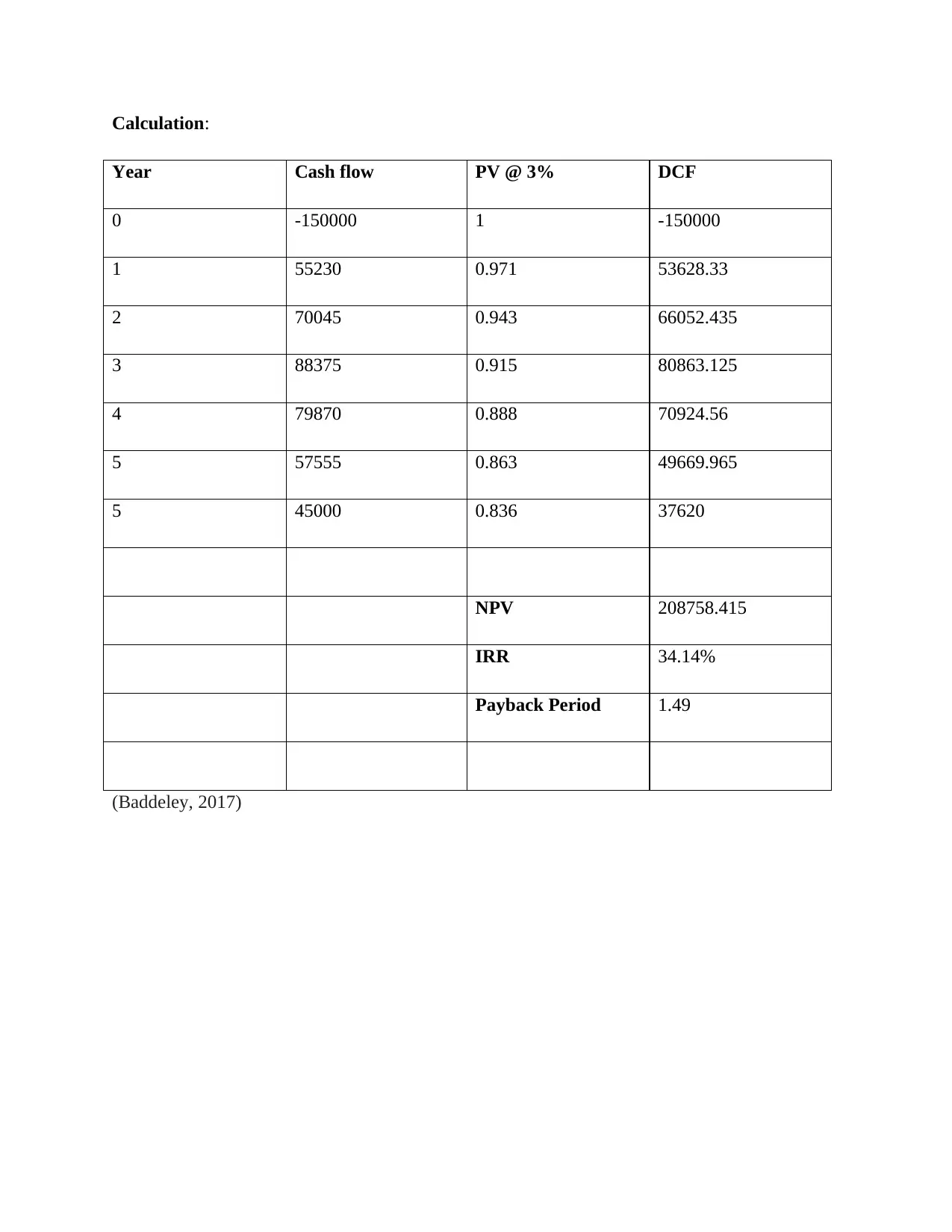
Calculation:
Year Cash flow PV @ 3% DCF
0 -150000 1 -150000
1 55230 0.971 53628.33
2 70045 0.943 66052.435
3 88375 0.915 80863.125
4 79870 0.888 70924.56
5 57555 0.863 49669.965
5 45000 0.836 37620
NPV 208758.415
IRR 34.14%
Payback Period 1.49
(Baddeley, 2017)
Year Cash flow PV @ 3% DCF
0 -150000 1 -150000
1 55230 0.971 53628.33
2 70045 0.943 66052.435
3 88375 0.915 80863.125
4 79870 0.888 70924.56
5 57555 0.863 49669.965
5 45000 0.836 37620
NPV 208758.415
IRR 34.14%
Payback Period 1.49
(Baddeley, 2017)
⊘ This is a preview!⊘
Do you want full access?
Subscribe today to unlock all pages.

Trusted by 1+ million students worldwide
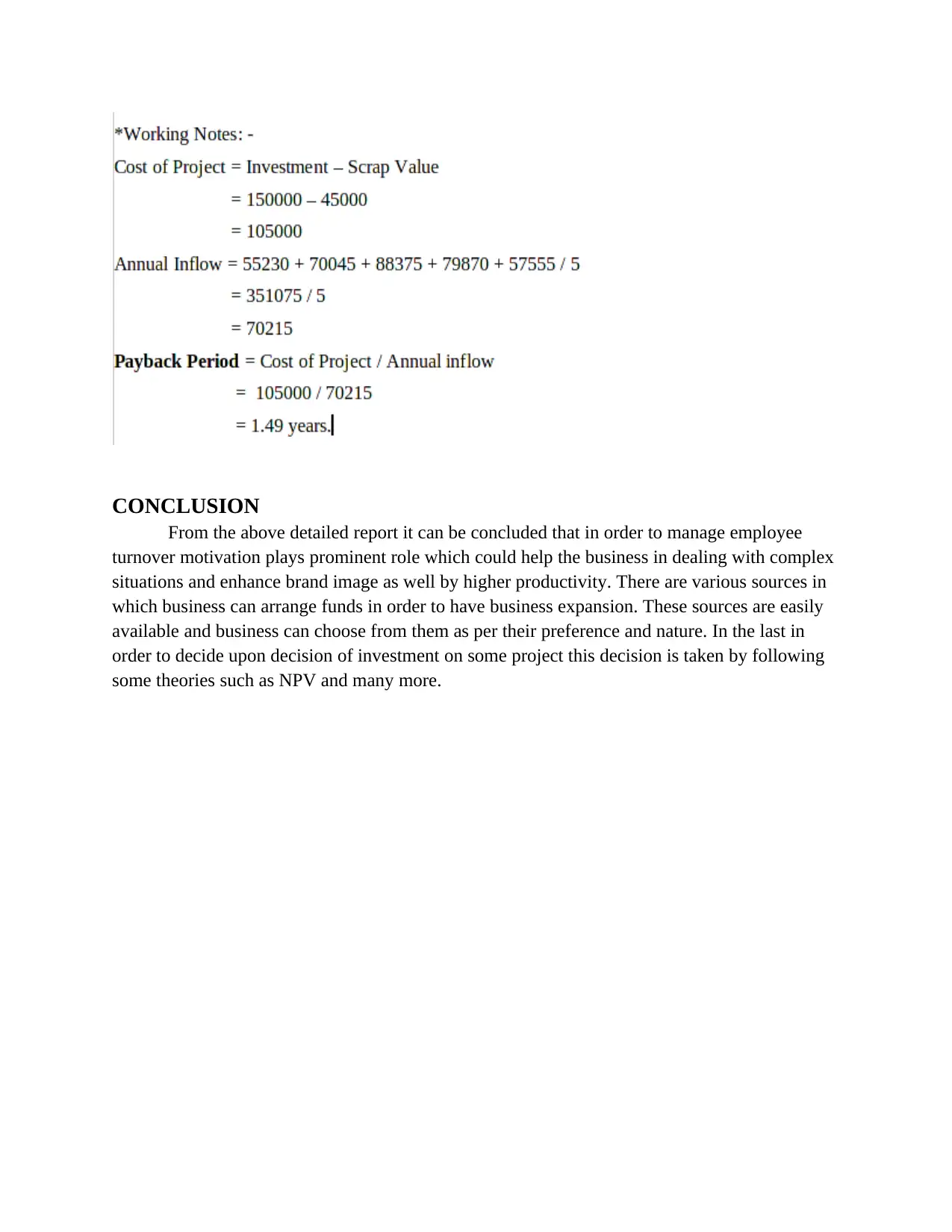
CONCLUSION
From the above detailed report it can be concluded that in order to manage employee
turnover motivation plays prominent role which could help the business in dealing with complex
situations and enhance brand image as well by higher productivity. There are various sources in
which business can arrange funds in order to have business expansion. These sources are easily
available and business can choose from them as per their preference and nature. In the last in
order to decide upon decision of investment on some project this decision is taken by following
some theories such as NPV and many more.
From the above detailed report it can be concluded that in order to manage employee
turnover motivation plays prominent role which could help the business in dealing with complex
situations and enhance brand image as well by higher productivity. There are various sources in
which business can arrange funds in order to have business expansion. These sources are easily
available and business can choose from them as per their preference and nature. In the last in
order to decide upon decision of investment on some project this decision is taken by following
some theories such as NPV and many more.
Paraphrase This Document
Need a fresh take? Get an instant paraphrase of this document with our AI Paraphraser
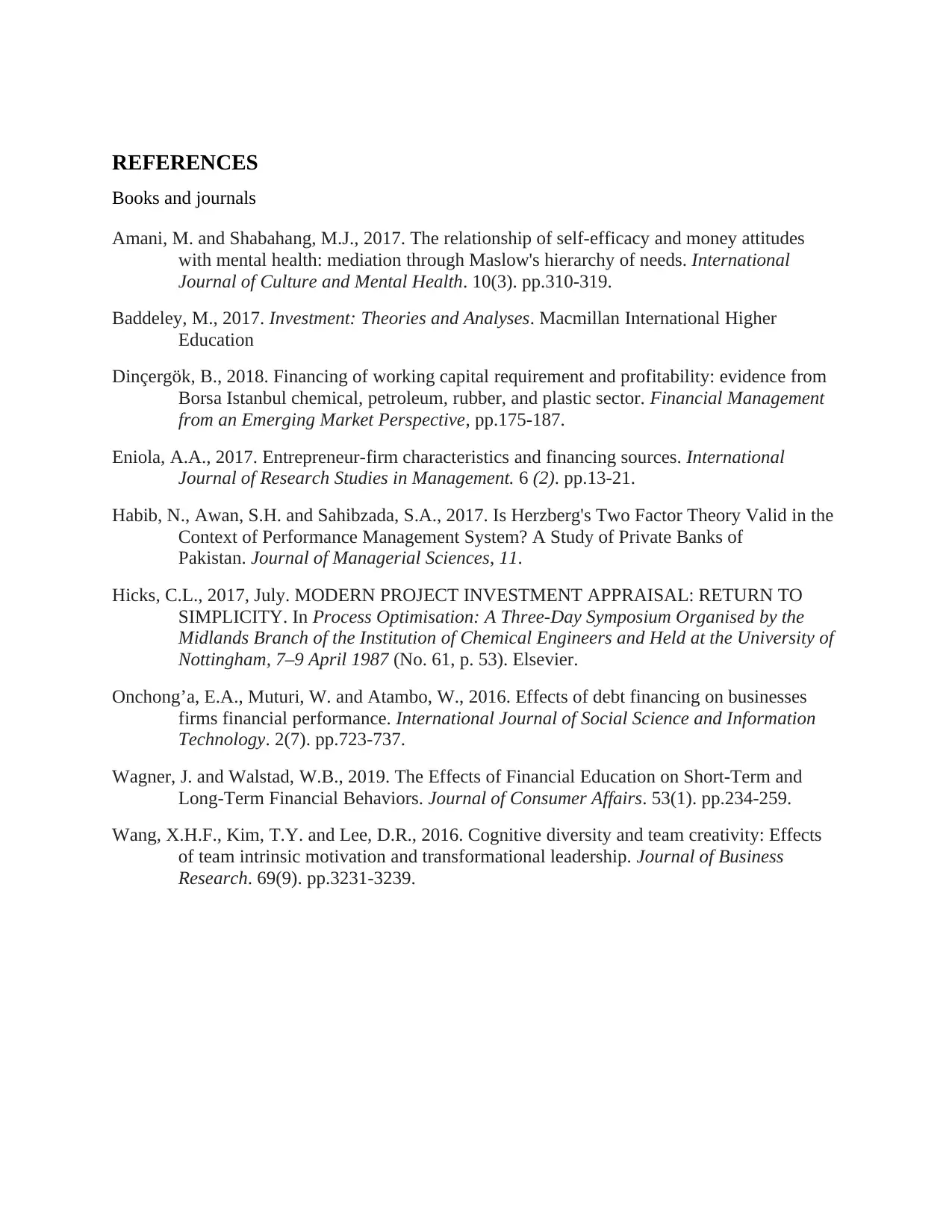
REFERENCES
Books and journals
Amani, M. and Shabahang, M.J., 2017. The relationship of self-efficacy and money attitudes
with mental health: mediation through Maslow's hierarchy of needs. International
Journal of Culture and Mental Health. 10(3). pp.310-319.
Baddeley, M., 2017. Investment: Theories and Analyses. Macmillan International Higher
Education
Dinçergök, B., 2018. Financing of working capital requirement and profitability: evidence from
Borsa Istanbul chemical, petroleum, rubber, and plastic sector. Financial Management
from an Emerging Market Perspective, pp.175-187.
Eniola, A.A., 2017. Entrepreneur-firm characteristics and financing sources. International
Journal of Research Studies in Management. 6 (2). pp.13-21.
Habib, N., Awan, S.H. and Sahibzada, S.A., 2017. Is Herzberg's Two Factor Theory Valid in the
Context of Performance Management System? A Study of Private Banks of
Pakistan. Journal of Managerial Sciences, 11.
Hicks, C.L., 2017, July. MODERN PROJECT INVESTMENT APPRAISAL: RETURN TO
SIMPLICITY. In Process Optimisation: A Three-Day Symposium Organised by the
Midlands Branch of the Institution of Chemical Engineers and Held at the University of
Nottingham, 7–9 April 1987 (No. 61, p. 53). Elsevier.
Onchong’a, E.A., Muturi, W. and Atambo, W., 2016. Effects of debt financing on businesses
firms financial performance. International Journal of Social Science and Information
Technology. 2(7). pp.723-737.
Wagner, J. and Walstad, W.B., 2019. The Effects of Financial Education on Short‐Term and
Long‐Term Financial Behaviors. Journal of Consumer Affairs. 53(1). pp.234-259.
Wang, X.H.F., Kim, T.Y. and Lee, D.R., 2016. Cognitive diversity and team creativity: Effects
of team intrinsic motivation and transformational leadership. Journal of Business
Research. 69(9). pp.3231-3239.
Books and journals
Amani, M. and Shabahang, M.J., 2017. The relationship of self-efficacy and money attitudes
with mental health: mediation through Maslow's hierarchy of needs. International
Journal of Culture and Mental Health. 10(3). pp.310-319.
Baddeley, M., 2017. Investment: Theories and Analyses. Macmillan International Higher
Education
Dinçergök, B., 2018. Financing of working capital requirement and profitability: evidence from
Borsa Istanbul chemical, petroleum, rubber, and plastic sector. Financial Management
from an Emerging Market Perspective, pp.175-187.
Eniola, A.A., 2017. Entrepreneur-firm characteristics and financing sources. International
Journal of Research Studies in Management. 6 (2). pp.13-21.
Habib, N., Awan, S.H. and Sahibzada, S.A., 2017. Is Herzberg's Two Factor Theory Valid in the
Context of Performance Management System? A Study of Private Banks of
Pakistan. Journal of Managerial Sciences, 11.
Hicks, C.L., 2017, July. MODERN PROJECT INVESTMENT APPRAISAL: RETURN TO
SIMPLICITY. In Process Optimisation: A Three-Day Symposium Organised by the
Midlands Branch of the Institution of Chemical Engineers and Held at the University of
Nottingham, 7–9 April 1987 (No. 61, p. 53). Elsevier.
Onchong’a, E.A., Muturi, W. and Atambo, W., 2016. Effects of debt financing on businesses
firms financial performance. International Journal of Social Science and Information
Technology. 2(7). pp.723-737.
Wagner, J. and Walstad, W.B., 2019. The Effects of Financial Education on Short‐Term and
Long‐Term Financial Behaviors. Journal of Consumer Affairs. 53(1). pp.234-259.
Wang, X.H.F., Kim, T.Y. and Lee, D.R., 2016. Cognitive diversity and team creativity: Effects
of team intrinsic motivation and transformational leadership. Journal of Business
Research. 69(9). pp.3231-3239.
1 out of 11
Related Documents
Your All-in-One AI-Powered Toolkit for Academic Success.
+13062052269
info@desklib.com
Available 24*7 on WhatsApp / Email
![[object Object]](/_next/static/media/star-bottom.7253800d.svg)
Unlock your academic potential
Copyright © 2020–2025 A2Z Services. All Rights Reserved. Developed and managed by ZUCOL.





